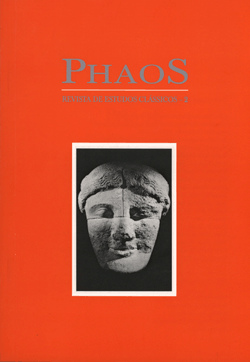"Como um raio fixo" - Goethe e Winckelmann: O classicismo e suas aporias
Palavras-chave:
Winckelmann. Goethe. Ekphrasis. Antiquity. Sublime.Resumo
This paper presents some main aspects of the classical conceptions of two authors: Johann Joachim Winckelmann and W. Goethe. Winckelmann's work is at the origin of both disciplines, Art History and Archeology. One of the main procedures ofhis work was the description of artworks, inside and beyond the rhetorical tradition of the ekphrasis. He idealized a certain Antiquity in his Reflections on the imitation of the Greeks from 1755 and deepened his historical reading of it in his History of the Art of Antiquity from 1764. Goethe was a reader of Winckelmann 's works and tried also to study Antiquity directly by traveling trough Italy. In both authors we see the search for an ideal projected in Antiquity, which is more and more tough under the key of an absence, as a negative of Modernity. In this sense, the notion of the sublime, as an aesthetic category that represents the incommensurability between the objective and the subjective sides of knowledge, and that those thinkers applied to the classical works of art, can be reverted and applied to the relation between Modernity and the classical world. Goethe's description of the Laocoon Group mirrors the scene of Modernity and its wounds, the "birth" of Modernity from the (absent) spÜit of Antiquity.Referências
BENJAMIN, Walter. "Goethes Wahlverwandtschaften", in: Gesammelte Schriften, organizado por R. Tiedemann e H. Schweppenhauser, Frankfurt a.M.: Suhrkamp, 1972 ss., vol. I, 1974, pp. 123-201.
BUSCH, Werner. Das sentimentalische Bild. Die Krise der Kunst im 18. Jahrhundert und die Geburt der Modeme, München: C. H. Beck, 1993.
GOETHE. Werke. Hamburger Ausgabe, München: Hanser, 1989.
GOETHE. "Antik und Moderne", Samtliche Schriften, Artemis Verlag/DTV, vol. XIII.
GOETHE. "Philostrats Gemälde", Sämtliche Schriften, Artemis Verlag/DTV, vol. XIII.
Heinrich Christoph Jussow 1754-1S25. Ein hessischer Architekt des Klassizismus, Museum Fridericianum, Staatliche Museen Kassel, 1999.
JOUIN, M. Henry, Conférences de l'Académie Royale de peinture et de sculpture recueillis, annotées et précédées d'une étude sur Les Artistes et le Écrivains de M. Henry jouin, Paris: A. Quantin imprimeur-éditeur, 1883.
KREIKENBOM, Detlev, "Verstreute Bemerkungen zu Goethes Anschauung antiker Kunst", in: Sabine Schulze (org.), Goethe und die Kunst, Frankfurt! Weimar: Hatje, 1994, pp. 31-46.
LACOUE-LABARTHE, Philippe e NANCY, Jean-Luc, O mito nazista, trad. M. Seligmann-Silva, São Paulo: Iluminuras, 2002.
LAUSBERG, Heinrich, Handbuch der literarischen Rhetorik, Stuttgart: Franz Steiner Verlag, terceira edição, 1990.
LESSING, G. E., Laocoonte. Ou sobre as Fronteiras da Poesia e da Pintura, trad. e notas M. Seligmann-Silva, São Paulo: Iluminuras, 1998.
MENDELSSOHN, Moses, "Über das Erhabene und Naive in den schonen Wissenschaften" in: M. Mendelssohn, Asthetische Schrjften, org. Otto F. Best, Darmstadt: Wissenschaftliche Buchgesellschaft, 1986.
Mythologie der Vernunft. Hegels "älteste Systemprogramm" des deutschen Idealismus, org. por Christoph Jamme e Helmut Schneider, Frankfurt a.M.: Suhrkamp, 1984.
POTTS, Alex, Flesh and the Ideal. Winckelmann and the origins of art histoq, New Haven/ London: Yale UP, 1994.
PFOTENHAUER, Helmut, "Winckelmann und Heinse. Die Typen der Beschreibungskunst im 18. Jahrhundert oder die Geburt der neueren Kunstgeschichte", in: Gottfried Boehm e Helmut Pfotenhauer (org.), Beschreibungskunst - Kunstbeschreibung, Munique: Fink, 1995, pp. 313-340.
SELIGMANN-SILVA, Márcio. "Filosofia da tradução - Tradução de Filosofia: o Princípio da Intraduzibilidade", in: Cadernos de Tradução, n. 3, UFSC, 1998, pp. 11-47.
SELIGMANN-SILVA, Márcio. "Introdução / Intradução. Mimesis, tradução, Enárgeia e a Tradição da ut pictura poesis", in: G.E. Lessing, Laocoonte. Ou sobre as Fronteiras da Poesia e da Pintura, trad. e notas M. Seligmann-Silva, São Paulo: Iluminuras, 1998.
SELIGMANN-SILVA, Márcio. "Do delicioso horror sublime ao abjeto e à escritura do corpo", in: Ana Luiza Andrade, M. L. de Barros Camargo e R. Antelo (org.), Leituras do ciclo, Florianópolis: ABRALIC, 1999, pp. 123-136.
STAROBINSKI, Jean, 1789. Os emblemas da Razão, trad. M. L. Machado, São Paulo: Companhia das Letras, 1988.
SZONDI, Peter, "Antike und Moderne in der Ásthetik der Goethezeit", in: P. Szondi, Poetik und Geschichtsphi1osophie I. Studienausgabe der Vorlesungen, Band 2, Frankfurt a.M.: Suhrkamp, 1984.
TAUSCH, Harald, Entfernung der Antike. Carl Ludwig Fernow im Kontext der Kunsttheorie um 1800, Tübingen: Niemeyer, 2000.
WINCKELMANN, J. J. Von der Nachahmung der griechischen Werke in der Malerei und Bildhauekunst, in: Winckelmann, Anton Raphael Mengs e Wilhelm Heinse, Frühk1assizismus, org. por Helmut Pfotenhauer et alii, Frankfurt/Main: Deutsche Klassiker Verlag, 1995.
WINCKELMANN, J. J. Geschichte der Kunst des Altertums, Darmstadt: Wissenschaftliche Buchgesellschaft, Bibliothek Klassischer Texte, 1993.
Downloads
Publicado
Edição
Seção
Licença
Ao se submeterem textos para a PhaoS, seus autores devem estar cientes de que, se aprovados para publicação, a revista terá sobre eles todos os direitos autorais pertinentes. Originais não serão devolvidos.

